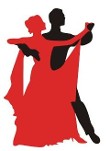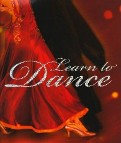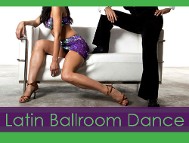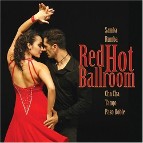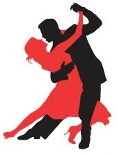Line Dance

Line Dance Tutorials and Resources
Some Beginning Line Dancing Basics
Here’s a little more information about line dancing if you’re new to all this and a little confused about what is happening out there on the floor–I know I was!
A couple of things to know about if you’re new! Line dances are typically 16, 32, 40 or 48 steps (based on the level of difficulty) You may have noticed these numbers are all divisible by 8! Most popular music has a 4/4 time signature, but dancers count beats in sets of 8, hence line dance choreography is grouped and taught in sets of 8 or with “8-count.”
Next (and the other major thing), line dances are known for having one, two or four walls. A one-wall dance means everyone will face in the same direction when all steps are performed. A two-wall line dance is when at the end of each sequence of steps everyone has turned 180º and you begin again facing the back — for these dances, you will always just face the “front” and “back” walls. Then, with a four-wall line dance (the most difficult), at the end of the steps, everyone has turned 90º and “begins the dance” again facing one of the “side” walls. As the dance progresses you will keep finishing and starting again facing a new wall.
TIP: When first learning and taking a class it is tempting to hide in the last row! But as you may have already guessed, that’s a bad idea! As soon as the dance has moved on to the back wall, if you were in the back, you are now in the front! You can’t see anyone and everyone is looking at you! So, find a good spot somewhere in the middle and you’ll be able to always watch someone who knows what they are doing!
Beginner Line Dance Tips
That first night on the floor during your first lesson, you may feel a little overwhelmed. The key is to be patient and not give up. The first time I ever tried to learn a line dance I walked off the floor about 1/2 way through the lesson! The next time I made it about 3/4 through, and then the third try I did it! I just had to keep coming.
Here are some tips for taking free group lessons, whether it be in your local country bar or a community center where there are lessons. If you are a beginner it can be more challenging than you thought. It takes a little while to get used to memorizing choreography and developing muscle memory for all the steps and at the speed of the dance.
1. Watch YouTube! I know I already mentioned this. But use YouTube to get ready before you even go. See if the bar has a schedule of what lessons will be taught and look it up to see if there’s a YouTube video of that dance. Even if you don’t totally get it down at home it will help. I’ve even thought I had it down at home, only to still feel a little lost during the lesson. But the at-home practice gave me a clue what was happening and the leg-up I needed.
2. Stand in the middle! One thing about a typical line dance is that it has “walls.” As it progresses, it turns. When the sequence of steps in the dance end, it is designed to have you facing either the next wall to your right to start over or even the “back” wall to start again. The idea here is not to try to “hide in the back!” If you’re in the back row, as the dance progresses you will then find yourself in the front! Everyone will be looking at you, and you won’t be able to watch anybody.
Stay in the middle so that as the dance progresses there will always be someone in front of you that you can watch. You’ll also have a closer view of the teacher as they show the steps.
3. Know some Basics. Another thing that can help you be successful is to do a little study of some basic line dance terminology before you go out to the local bar. But, no worries! Here’s a couple things right here for you to know:
The first thing is that Line dances are typically 16, 32, 40, 48 and even 64 steps (based on the level of difficulty). You may have noticed these numbers are all divisible by 8! The music typically will have a 4/4 time signature, but dancers count beats in sets of 8, hence line dance choreography is grouped and taught in sets of 8 or with “8-count.”
Next, line dances are known for having one, two or four walls. A one-wall dance means you will end up facing the same direction when all steps are performed. In a two-wall line dance, at the end, everyone has turned 180º and the dance starts again with everyone facing the back.
Then, with a four-wall line dance (the most common), at the end of the steps, everyone has turned 90º when they start the steps again. As the dance progresses you will keep finishing and starting again facing the next wall to the right.
These walls are known by the numbers on a clock. At the start, everyone is facing the “12 o’clock wall.” Then after the steps are performed the dance begins again on the “3 o’clock wall” etc.
4. Social Connections. So, that’s the basics and enough to give you a jump start to getting involved with line dancing. But the final thing to know is that line dancing is a great way to connect with people. I would be remiss not to mention a big part of my improvement as a dancer is largely due to the friends I’ve made while doing it. There are some really great and genuine people in the country dancing community, and really, staying connected to people ends up being the main thing. You just end up becoming a better dancer also!
Ballroom Basic Line Dances
Line Dance Terms Steps & Sequences
Line Dance Basic Steps
Line Dance Basic Steps
53 Line Dancing Steps You Need to Know!
Linedance Steps, Video contains 47 common steps used to create a scripted Dance
Top Ten Steps Part 1
Top Ten Steps Part 2
Top Steps Part 3
Intro to Line Dance
Introduction to Line Dance Steps Prequel
Introduction to Line Dance Steps Part Four
Diane Ellis Introduction to Line Dance Steps #1
Diane Ellis Introduction to Line Dance Steps #2
Terms & Glossary
Basic Line Dance Terms
BASIC TERMS is a list of line dance steps and sequences. Use this as a worksheet to keep track of and take notes on what you have learned.
DANCE GLOSSARY This glossary of terms provides definitions for most of the basic line dance steps and sequences together with a description of how to execute each move.
CopperKnob - Line Dance Articles
Demonstrations of Basic Line Dance Terms, Steps and Sequences:
Basic Line Dance Terms
Basic Line Dance Steps
Basic Sequence descriptions No. 1 of 2
Basic Sequence descriptions No. 2 of 2
Basic line dance steps for Beginners
Basic Linedance Steps for beginners
Basic Linedance Steps II for beginners
Line Dancing for Seniors (1992) - Sample Clip
Introduction to Line Dance Steps Part 1
Introduction to Line Dance Steps Part 2
Introduction to Line Dance Steps Part 3
One Step at a Time
Linedance Steps, Video contains 47 common steps
DANCING DETERS ALZHEIMER'S This is a must read flyer that cites research showing that line dancing is one of the best exercises to help deter Alzheimer's.
Fitness Benefits of Line Dancing
All together now! Line dancing for fun and fitness
Five Benefits of Line-Dancing for Seniors
HEALTH BENEFITS OF DANCE
Fitness Benefits of Line Dancing | Mynette Aguilar - Academia.edu
Line Dancing with Patti
Workshop Intro
https://youtu.be/eDhKWZO8fno
Rhythm Issues
https://youtu.be/mFQXPDxgBTM
Top Ten Steps Part 1
https://youtu.be/BOyITcqCrLI
Top Ten Steps Part 2
https://youtu.be/VRzvhBmSRy0
Top Steps Part 3
https://youtu.be/9_I61pIvjtQ
Let's Talk About Line Dance Turns! Dancing With Patti
https://youtu.be/o2gFQZq1jaI
Basic Steps: Turns
https://youtu.be/OTOkKKO58-U
DWP Beginner Line Dance Workshop
https://youtu.be/mb2hQoy8Wj8
————
Basic Steps: Step Touch, Locking Steps, Rock Recover, Mambo Steps
https://youtu.be/gsvQs7MLXRE
Basic Steps: Vine, Weaves, Scissor Steps
https://youtu.be/MxLlWsUjBy0
Basic Steps: Jazz Box, Kick Ball Change, Rocking Chair, Kick and Point
https://youtu.be/8EyKKmYWxQ4
Basic Steps: Vines, Weaves, Scissor Steps
https://youtu.be/DoLRydu-hUI
Basic Steps: Triples (shuffles), Coasters, Sailors
https://youtu.be/M_6YIP38MSI
Basic Steps: Turns
https://youtu.be/OTOkKKO58-U
Basic Steps: Crossing Shuffles, Wizard Steps
https://youtu.be/vGAejBjto3k
Puttin On The Nines Demo and Teach
https://youtu.be/qSUYFlQJCXU
Drinkin Bone Boogie Teach and Demo
https://youtu.be/-r-eVl4fWJM
Basic Steps Broken Down - Vintage DWP :)
https://youtu.be/rQOJTdaGoLc
Basic Line Dance Step Videos
These are some very well made videos by 2 other instructors to help you learn the basic terms, steps & patterns in line dancing. I want to help you with your learning process. Let me know if you have any questions or suggestions.
Vickie Jackson YouTube Video Instruction
Basic Line Dance Terms
Basic Line Dance Steps
Basic Sequence descriptions No. 1 of 2
Basic Sequence descriptions No. 2 of 2
Lia Linedance YouTube Video Instruction
Lia Linedance videos - Lia's YouTube Channel
47 Common Steps used in line dance
1/4 Pivot Turns - Right & Left
Half Pivot Turns - Right & Left
Coaster Step - Right & Left
Grapevines - Right & Left
Jazz Box - Right & Left
Rocking Chair - Right & Left
Rock Back - Right & Left
Rock Forward - Right & Left
Sailor Shuffles - Right & Left
Back Triple Step or Shuffle Back - Right & Left
Forward Triple Step or Shuffle Forward - Right & Left
Side Triple Step or Side Shuffle or Chasse - Right & Left
Triple Step or Cha Cha - Right & Left
Basic Line Dance Instruction VIdeos
https://www.ilovemywork.com/ basic-instruction-videos/
Linedance Steps, Video contains 47 common steps.
https://youtu.be/nHUpmmHRZr8
Linedancing Etiquette| Basic Steps
https://www.linedancecairns. com/helpful-hints
HELPFUL HINTS
What to Wear
Comfortable shoes appropriate for dancing. No thongs, please. Bring a couple of different shoe types to try. In Cairns, it is recommended that you wear loose clothing.
What is Line Dancing?
Line dancing is an easy to learn dance format where, as its name implies: people dance in lines to music. Line dances are choreographed dances with a repeating series of steps that are performed in unison by a group of people in lines or rows, usually facing in the same direction.
Although many popular line dances are set to country music (boot scooting), the first line dances were done to contemporary music - pop and rock 'n roll.
Line Dancing Today
In the USA line dancing is most commonly taught and practiced in country and western dance bars, social clubs and dance halls, with the accompanying blue jeans, cowboy hats and boots.
The scene is slightly different in Australia where you can now find yourself dancing not just to the traditional country and western music but to a number of different music styles including rock and roll, waltz, Latin (cha cha, mambo, rhumba), and Irish.
Line Dance Steps
Basic line dances focus on movements of the legs and feet, with more advanced dances including the arms and hands. The movements of a line dance are marked as "counts" where one count generally equals one musical beat, with a particular movement or step taking place at each beat.
Line dances are made up of a series of different steps, with each step sequence identified by a catchy name.
Dance Floor Etiquette
Beginners Guide
Basic Line Dance Steps
http://roots-boots.net/ldance/ etiquitte.html
http://roots-boots.net/ldance/ beginner.html
The following is not meant to be a "you must obey or else" list of rules and regulations - after all, we're all on the floor to have *fun*. Rather it is just a list of suggestions which dancers are encouraged to follow to make things more enjoyable for both yourself and others. In other words, it's about being polite and considerate. Not to suggest that anyone is intentionally anything but, of course. *grin*
For those who've been dancing since Adam and Eve .. well since the days of Achy Breaky Heart .. please be tolerant of those who're new to line dancing. They'll pick things up eventually and, remember, you were a novice once.
Most of these suggestions are just plain common sense - but I've heard all too many people complain, dancers and instructors/DJ's alike, about most of the following at one time or another (and I'm as guilty as the next person) - so we could all do with a bit of a reminder now and again, whether we've only just started dancing or we've been doing it for donkey's years.
If there're any suggestions you'd like to see added to this list, please email them and I'll add them in.
Dance Hall Etiquette
Always listen to the DJ. It's their job to ensure things go smoothly and it's your job to heed them. It is customary for the DJ to also announce which dance is to be done to the music and to also count it in.
If the DJ does a good job, let them know you have appreciated their efforts. People are all too willing to air a complaint, but compliments are few and far between. DJ's, like beginners, thrive on compliments - and you are more likely to get your requests played, especially if they are dances only a handful know.
Food, drinks, chewing-gum or cigarettes should NEVER be carried onto the dance floor. It's both dangerous and unpleasant.
Never stay on the floor to talk - if you want to chat, leave the dance floor. This includes standing around the edges of the dance floor - dances can and often do move from one side of the floor to the other and no dancer likes running into or trying to dodge a "chatter".
NEVER walk through a line of dancers to cross the floor. If you have to get from once side of the dance floor to the other, walk around the floor or wait until the dance has stopped. Remember, a dance floor is for dancing - it's not a footpath!
Remember everyone was once a beginner, do try to be helpful to newcomers.
If you are seated or standing around the edge of the dance floor, please be considerate of those dancing - if the dancers moves towards you, move out of their way.
If you are dancing away from your usual haunts and you find the regulars are doing a dance differently or to another song don't tell 'em they're wrong - line dances tend to vary considerably from place to place.
Dancing Etiquette
Give your fellow dancers room to move. Don't hog floor space at their expense and don't accidently dance on top of them.
If you are a beginner, tolerate experienced dancers. They may need a little more room than you might expect. For everyone else - remember, you were a beginner once.
The first line always picks the dance if the DJ does not call it. If you don't know the dance, dance in another part of the floor where you are not in anyone's way.
If the dance floor is empty and you are starting off the dance, go to the front so that others can line up behind you.
If the dance has already started when you arrive on the dance floor, pick up the dance at whatever point those already on the floor are at. Linedancing is all about dancing in step with everyone else, after all. Also join the end of a line, not the middle!
Don’t be tempted to stop dancing to teach, especially if there is no room. Try to teach off the floor if you can find space. On the other hand, if you notice someone nearby who is having trouble, it is quite acceptable to call out the steps (but not too loudly), whilst continuing to dance yourself. This in fact is a good thing to do - it's a great encouragment.
When dancing near beginners be mindful and courteous and don’t show off. Too many variations can put people off if they are unsure of themselves. If you want to enliven a beginner level dance, do it away from any beginner dancers.
Beginner's are advised to stick to the centre of the dance floor - that way, no matter what wall you may be facing, there will be someone in front of you who (hopefully) knows the dance and whom you can follow. The reverse of this is that advanced dancer's should try to stick to the sides.
If the floor is crowded, take small steps, but watch out for collisions.
If you bump into someone, it is customary to apologise whether it is your fault or not. It never hurts to be polite.
The dance floor is divided into two sections:
CENTRE: for the line dances
OUTSIDE: (around the line dancers) for two steppers and swing dancers
Of course, you wont always have two-steppers or swing dancers, but if you are near the edge of the dance floor it is always a good idea to kept alert to the possibility - especially at a social. Those dancing around the outside lane have the right of way. Of course, if the floor is packed with line dancers, it's not a good time to try two-stepping.
For two-steppers (or other's dancing around the floor), the line of dance is always anti-clockwise.
While line dancers should stay in the centre, away from the two-steppers etc, the latter should also stay away from the centre and not wander into the lines nor cut the corners.
The dance floor may be further divided if more than one linedance can be done to a particular song. Generally the more advanced dance is to the rear of the floor, however this is usually at the discretion of the DJ. When there is a split floor (whether with two, three or even more dances), it is a good idea to leave as much distance as possible between the different dances, especially if one or more of them moves considerably. If the dance floor is crowded, it is not a good idea to split the floor. If you are at a class, it is not good form to attempt an alternative dance unless the instructor OK's it. If you really must do your own dance in class whilst the other's are doing something else or if you want to do a solo act at a social, then it is advisable to do so discretely, putting as much distance as possible between yourself and the other dancers. If this sounds picky, just recall how many times you've miss-stepped when someone near you makes a mistake or does something unchoreographed.
And remember .. linedancing is meant to be fun, both for you and everyone else on the dance floor.
